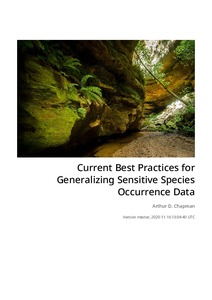| dc.contributor.author | Chapman, Arthur D. | |
| dc.date.accessioned | 2020-11-26T12:29:26Z | |
| dc.date.available | 2020-11-26T12:29:26Z | |
| dc.date.issued | 2020 | |
| dc.identifier.citation | Chapman, A.D. (2020) Current Best Practices for Generalizing Sensitive Species Occurrence Data. Copenhagen, Denmark: Global Biodiversity Information Facility (GBIF) Secretariat, 50pp. DOI: https://doi.org/10.15468/doc-5jp4-5g10. | en_US |
| dc.identifier.uri | http://hdl.handle.net/11329/1460 | |
| dc.identifier.uri | http://dx.doi.org/10.25607/OBP-962 | |
| dc.description.abstract | The unprotected distribution of Sensitive Primary Species Occurrence Data (for example the exact
localities of rare, endangered or commercially valuable taxa) was a concern of GBIF
[https://www.gbif.org] – the Global Biodiversity Information Facility – from its beginning. The GBIF
Secretariat has a vested interest in making data available via its portals, but at the same time
respecting the wishes of data providers to restrict information on sensitive taxa. In early 2006, GBIF
initiated a process to address this issue, especially in relation to data to be shared through the GBIF
network and made visible through GBIF.org [https://www.gbif.org] and other data aggregating
initiatives.
This resulted in the Guide to Best Practices for Generalising Sensitive Primary Species Occurrence Data
[https://doi.org/10.15468/doc-b02j-gt10]. That document relied heavily on the results of an online survey
conducted through Survey Monkey [https://www.surveymonkey.com] and subsequent workshops whose
reports were originally made available on the GBIF website (Chapman 2006 [https://doi.org/10.35035/
vs84-0p13]).
A final report on Dealing with Sensitive Primary Species Occurrence Data was developed following
these processes and discussions, and was presented to GBIF in April 2007 (Chapman 2007
[https://doi.org/10.35035/rajc-t668]). This report made a number of recommendations, and many of these
have been included in this document.
The final step in that process was to develop a Guide to Best Practices for Primary Species Occurrence
Data. That document was proposed as an overriding guideline for institutions, data providers and
GBIF Nodes to use to develop their own in-house guidelines. Organizations and institutions were
encouraged to produce their own internal documents that incorporated the practices outlined in the
Guide and related documents such as the Guide to Best Practices for Georeferencing [https://doi.org/
10.15468/doc-2zpf-zf42] (Chapman and Wieczorek 2006) and incorporate them into their own working
environment. Unfortunately, not as many institutions have taken up the challenge and produced
their own internal documents as we had hoped. Two key agencies that have done so, however, are
SANBI in South Africa (SANBI 2010 [http://biodiversityadvisor.sanbi.org/wp-content/uploads/2012/09/SANBIBiodiversity-
Information-Policy-Series-Digital-Access-to-Sensitive-Taxon.pdf]) and the Atlas of Living Australia
(Tann and Flemons 2009 [https://www.ala.org.au/wp-content/uploads/2010/07/ALA-sensitive-data-report-andproposed-
policy-v1.1.pdf], ALA 2018a [https://support.ala.org.au/support/solutions/articles/6000195500-what-issensitive-
data-]) (see Implementations).
It is also important to understand the possible impact that approaches for restricting sensitive data
may have on biodiversity science and, while restricting the availability or resolution of certain data,
not overly restricting the uses to which the data may be put. For that reason, a set of principles are
elucidated below. Key among these is the need to make biodiversity information freely available
wherever possible, in the interests of science, the environment and biodiversity itself. | en_US |
| dc.language.iso | en | en_US |
| dc.publisher | Global Biodiversity Information Facility (GBIF) Secretariat | en_US |
| dc.rights | Attribution-ShareAlike 4.0 International | * |
| dc.rights.uri | http://creativecommons.org/licenses/by-sa/4.0/ | * |
| dc.subject.other | Sensitive data | en_US |
| dc.subject.other | GBIF | |
| dc.subject.other | Species conservation | |
| dc.title | Current Best Practices for Generalizing Sensitive Species Occurrence Data. Version 1. | en_US |
| dc.type | Report | en_US |
| dc.description.status | Published | en_US |
| dc.format.pages | 50pp. | en_US |
| dc.description.notes | Based on the earlier publication by Chapman AD & Grafton O (2008) Guide to Best Practices for Generalising Sensitive Species-Occurrence Data. Copenhagen: GBIF Secretariat. https://doi.org/10.15468/doc-b02j-gt10. | |
| dc.description.refereed | Refereed | en_US |
| dc.publisher.place | Copenhagen, Denmark | en_US |
| dc.identifier.doi | 10.15468/doc-5jp4-5g10. | |
| dc.subject.parameterDiscipline | Parameter Discipline::Biological oceanography::Biota abundance, biomass and diversity | en_US |
| dc.subject.dmProcesses | Data Management Practices::Data archival/stewardship/curation | en_US |
| dc.subject.dmProcesses | Data Management Practices::Data exchange | en_US |
| dc.description.currentstatus | Current | en_US |
| dc.description.sdg | 14.A | en_US |
| dc.description.bptype | Best Practice | en_US |
| dc.description.bptype | Manual (incl. handbook, guide, cookbook etc) | en_US |
| obps.contact.contactname | Arthur D. Chapman | |
| obps.contact.contactemail | info@gbif.org | |
| obps.contact.contactorcid | https://orcid.org/0000-0003-1700-6962 | |
| obps.resourceurl.publisher | https://docs.gbif.org/sensitive-species-best-practices/master/en/ | en_US |
 Repository of community practices in Ocean Research, Applications and Data/Information Management
Repository of community practices in Ocean Research, Applications and Data/Information Management

